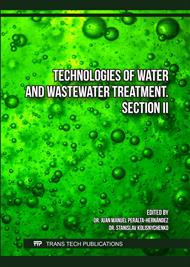p.303
p.314
p.320
p.325
p.333
p.338
p.344
p.353
p.359
The Adsorption and Regeneration of Magnetic Modified Bentonite Composite for Dye Wastewater
Abstract:
Bentonite has strong adsorption for cationic dyes. But as dye absorbent, it's difficult for them to recycle and regenerate. In order to solve these problems, a kind of magnetism bentonite composite was prepared by coprecipitation method, and H2O2/UV process was attempted to regenerate the spent composite. The results showed that the composite still has high adsorption performance for cationic dye methylene blue (MB), and the introduction of magnetite can achieve rapid solid-liquid seperation of composite in the external magnetic field. For the spent composite, its adsorption performance could be recovered by H2O2/UV process. The recovery effect is directly related to the dosage of hydrogen peroxide. In this study, as the dosage of hydrogen peroxide was 3% (volume ratio), the adsorption efficiency of spent composite for MB could almost return to its initial level after 3h regeneration. This research is of great significance to improve the utilization of bentonite adsorbent in water treatment engineering, and can also provide technical reference for the recycle and regeneration of other adsorbent materials.
Info:
Periodical:
Pages:
338-343
Citation:
Online since:
January 2022
Authors:
Keywords:
Price:
Сopyright:
© 2022 Trans Tech Publications Ltd. All Rights Reserved
Share:
Citation:



